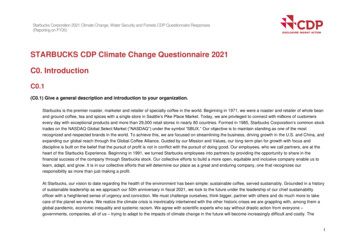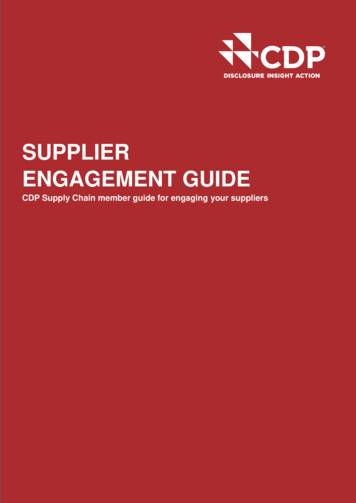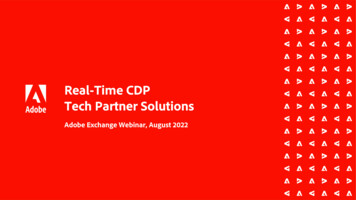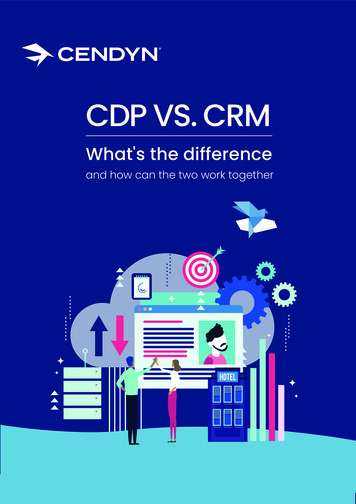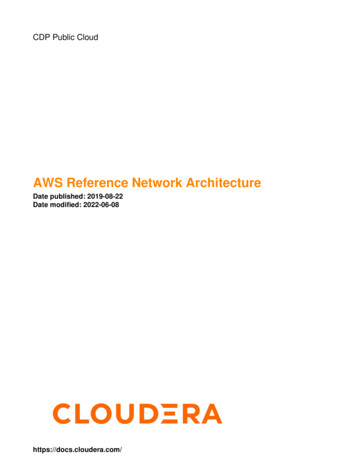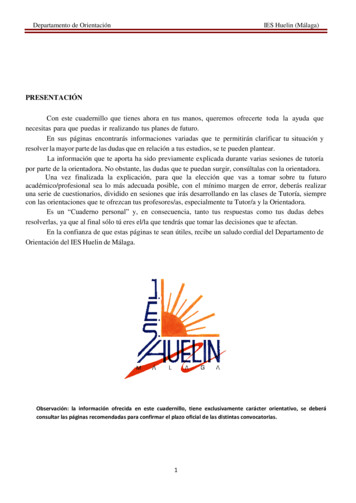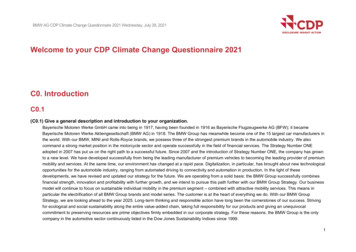
Transcription
BMW AG CDP Climate Change Questionnaire 2021 Wednesday, July 28, 2021Welcome to your CDP Climate Change Questionnaire 2021C0. IntroductionC0.1(C0.1) Give a general description and introduction to your organization.Bayerische Motoren Werke GmbH came into being in 1917, having been founded in 1916 as Bayerische Flugzeugwerke AG (BFW); it becameBayerische Motoren Werke Aktiengesellschaft (BMW AG) in 1918. The BMW Group has meanwhile become one of the 15 largest car manufacturers inthe world. With our BMW, MINI and Rolls-Royce brands, we possess three of the strongest premium brands in the automobile industry. We alsocommand a strong market position in the motorcycle sector and operate successfully in the field of financial services. The Strategy Number ONEadopted in 2007 has put us on the right path to a successful future. Since 2007 and the introduction of Strategy Number ONE, the company has grownto a new level. We have developed successfully from being the leading manufacturer of premium vehicles to becoming the leading provider of premiummobility and services. At the same time, our environment has changed at a rapid pace. Digitalization, in particular, has brought about new technologicalopportunities for the automobile industry, ranging from automated driving to connectivity and automation in production. In the light of thesedevelopments, we have revised and updated our strategy for the future. We are operating from a solid basis: the BMW Group successfully combinesfinancial strength, innovation and profitability with further growth, and we intend to pursue this path further with our BMW Group Strategy. Our businessmodel will continue to focus on sustainable individual mobility in the premium segment – combined with attractive mobility services. This means inparticular the electrification of all BMW Group brands and model series. The customer is at the heart of everything we do. With our BMW GroupStrategy, we are looking ahead to the year 2025. Long-term thinking and responsible action have long been the cornerstones of our success. Strivingfor ecological and social sustainability along the entire value-added chain, taking full responsibility for our products and giving an unequivocalcommitment to preserving resources are prime objectives firmly embedded in our corporate strategy. For these reasons, the BMW Group is the onlycompany in the automotive sector continuously listed in the Dow Jones Sustainability Indices since 1999.1
BMW AG CDP Climate Change Questionnaire 2021 Wednesday, July 28, 2021We don’t just do sustainability at BMW: We are making BMW sustainable. Sustainability is a key component of our BMW Group Strategy and makes animportant contribution towards our competitive edge. As a premium manufacturer, the BMW Group aspires to lead the way in terms of sustainability. Itis therefore taking responsibility and placing this topic at the core of its corporate strategy moving forward. This change has involved taking a majorstep, as the BMW Group is including sustainability as a prime factor in its corporate decision-making processes. Using a so-called “environment radar”which includes ecological and social criteria, engaging in dialogue with stakeholders, taking sustainability into account in all decisions and keeping atight watch over the whole value-added chain are key elements of our sustainability management. Corporate sustainability measured in balancedscorecard terms (at Group level) was first included as a formal corporate objective at the beginning of 2009. Detailed targets are then derived for eachof the divisions within the Group. Today, every project must be measured in terms of corporate sustainability. This involves measuring the consumptionof resources, emission levels as well as the social and socio-political consequences of the various solutions at hand.The Board of Management works to ensure that the BMW Group Strategy is aligned with sustainability in the long term. In 2019, the special-purposeSustainability Board was fully involved in regular Board of Management meetings, allowing sustainability issues to be even more consistently integratedinto the company’s decision-making processes. Since then, sustainability issues have been treated like every other topic and discussed as needed atfortnightly Board of Management meetings. All specific decisions referred to the Board of Management are subject to a mandatory sustainabilityevaluation. The decisions to be made by the Board of Management are prepared by the Strategy & Structure Circle. This group consists of the topmanagement of the company divisions and also addresses sustainability issues.C0.2(C0.2) State the start and end date of the year for which you are reporting data.Reporting yearStart dateEnd dateIndicate if you are providing emissions data for past reporting yearsJanuary 1, 2020December 31, 2020NoC0.3(C0.3) Select the countries/areas for which you will be supplying data.AustriaBrazilChinaGermany2
BMW AG CDP Climate Change Questionnaire 2021 Wednesday, July 28, 2021IndiaMexicoSouth AfricaThailandUnited Kingdom of Great Britain and Northern IrelandUnited States of AmericaC0.4(C0.4) Select the currency used for all financial information disclosed throughout your response.EURC0.5(C0.5) Select the option that describes the reporting boundary for which climate-related impacts on your business are beingreported. Note that this option should align with your chosen approach for consolidating your GHG inventory.Operational controlC-TO0.7/C-TS0.7(C-TO0.7/C-TS0.7) For which transport modes will you be providing data?Light Duty Vehicles (LDV)C1. GovernanceC1.1(C1.1) Is there board-level oversight of climate-related issues within your organization?Yes3
BMW AG CDP Climate Change Questionnaire 2021 Wednesday, July 28, 2021C1.1a(C1.1a) Identify the position(s) (do not include any names) of the individual(s) on the board with responsibility for climate-relatedissues.Position ofindividual(s)Please explainBoard-levelcommitteei) ExplanationThe highest level of direct responsibility for climate-related issues is the Board of Management. The Board determines the strategicdirection with regard to sustainability topics and climate change. Every document submitted to the Board for decision must include asustainability assessment of the planned project and / or the alternatives presented for decision.ii) Example of climate-related decisionsA recent example of a climate-related decision made by the Board of Management is the commitment to pursue a verifiable andconsistent path towards climate neutrality by 2050. In 2020, the Board of Management approved our integrated sustainability strategy,with concrete science-based targets for the first stage up to 2030. We are making BMW sustainable: by drastically reducing the carbonfootprint compared to 2019 per vehicle by 2030 - in production by 80 percent, during the use phase by more than 40 percent and in thesupply chain by at least 20 percent.C1.1b(C1.1b) Provide further details on the board’s oversight of climate-related issues.Frequency with whichclimate-related issuesare a scheduled agendaitemGovernance mechanisms intowhich climate-related issuesare integratedPlease explainScheduled – all meetingsReviewing and guiding strategyWe selected “scheduled – all meetings” as well as all “governance mechanisms” because itis OBLIGATORY and an integral component for EVERY SUBMISSION to the Board ofManagement to assess implications on sustainability issues such as resource consumptionReviewing and guiding majorplans of action4
BMW AG CDP Climate Change Questionnaire 2021 Wednesday, July 28, 2021Reviewing and guiding riskmanagement policiesReviewing and guiding annualbudgetsReviewing and guiding businessplansSetting performance objectivesMonitoring implementation andperformance of objectivesOverseeing major capitalexpenditures, acquisitions anddivestituresMonitoring and overseeingprogress against goals andtargets for addressing climaterelated issuesor impact on the environment.According to our vision of being the world’s most successful and sustainable premiumprovider of individual mobility many decisions are directly or indirectly linked to climaterelated issues. Sustainability is a core principle in our BMW Group Strategy and anchored inthe strategic approach. When the Board is reviewing and guiding our strategy as well asmajor plans of actions, business plans, annual budgets or overseeing major capitalexpenditures, acquisitions and divestitures sustainability plays a key role as part of ourstrategic approach. This is how the governance mechanisms contribute to the Board’soversight of climate issues.As a major EXAMPLE we mention our heavy investments in vehicle efficiency, electrificationwith plug-in hybrid and battery electric vehicles (PHEV / BEV) to support decarbonisation aswell as in joint ventures to support market penetration of BEVs. We currently offer 3 BEV and17 PHEV models with 2 more BEV models to come in 2021. By 2023, we will offer a total of25 electrified models, more than half of them pure electric. One model is the BMW iX(production start in 2021), which combines electric and Level 3 autonomous driving, highend connectivity and the interior of the future in a single vehicle for the first time – therebycreating a whole new experience of mobility. By 2025, the proportion of electrified vehicles inthe total deliveries is to rise to at least 25 %. By 2030, we plan to have delivered at leastseven million electrified vehicles. That is why we are relying on flexible platforms, wherecustomers can choose their drive train (BEV, PHEV, diesel or petrol) to suit their preference.Flexibility is our strategy for ramping up e-mobility, not stand alone electric platforms. All thisresults e.g. in the reduction of CO2 emissions of our newly sold vehicles in Europe (EU28)by 53 % between 1995 and 2020. Therefore we accomplished our goal to reduce CO2emissions until 2020, by at least 50 %. CO2-targets are monitored in vehicle markets toreach the increasingly strict regulatory requirements as well as our own ambitious standards.Expanding the charging infrastructure is a fundamental condition for the breakthrough of emobility. In founding the IONITY joint venture, the BMW Group together with other OEMs issetting the course for creating a high-performance fast-charging network for electric vehiclesin Europe. Therefore some 400 fast-charging stations are build up along major transport5
BMW AG CDP Climate Change Questionnaire 2021 Wednesday, July 28, 2021routes by 2021. Fast-charging stations make charging up to seven times faster thanstandard 50 kW stations.C1.2(C1.2) Provide the highest management-level position(s) or committee(s) with responsibility for climate-related issues.Name of the position(s) and/or committee(s)ResponsibilityBoth assessing and managing climateChief Development Officer, Member of the Board of Management related risks and opportunitiesof BMW AG, responsible for DevelopmentFrequency of reporting to the boardon climate-related issuesOther C-Suite Officer, please specifyMore frequently than quarterlyOther C-Suite Officer, please specifyHalf-yearlyBoth assessing and managing climateChief Production Officer, Member of the Board of Management of related risks and opportunitiesBMW AG, responsible for ProductionC1.2a(C1.2a) Describe where in the organizational structure this/these position(s) and/or committees lie, what their associatedresponsibilities are, and how climate-related issues are monitored (do not include the names of individuals).The answer explains (i) where in the organization the position lies, (ii) what the rationale and responsibilities are and (iii) how climate change (CC)related issues are assessed and monitored.A. “Chief Development Officer”:(i) The Member of the Board of Management of BMW AG responsible for Development (MBoMD) leads the R&D department. He is accountable for alldecisions for the R&D department, based on the strategic orientation and decision framework stipulated at Board of Management (BoM) meetingsbeing the highest body.(ii) The MBoMD is responsible for all the activities in the R&D department. A key issue is energy consumption and CO2-emissions of BMW Group‘sworldwide vehicle fleet. Therefore, a key process entails us defining specific CO2-targets for each product line and each new vehicle project in order to6
BMW AG CDP Climate Change Questionnaire 2021 Wednesday, July 28, 2021achieve our strategic targets on vehicle fleet CO2-emissions as well as all regulatory requirements worldwide. Our Strategy unit is responsible formonitoring and further developing these targets.The “Complete Vehicle Architecture” unit within the R&D department coordinates the development and implementation of fuel-saving technologies inthe individual vehicle projects. This ensures that the market-specific fleet requirements are taken into consideration in the very early stages of vehicledevelopment and are subject to Efficient Dynamics (ED) measures during the development process. Under the term ED, we have been successfullyworking on reducing fuel consumption and vehicle emissions through the development of highly efficient combustion engines, electrificationrespectively plug-in hybrid electric vehicles (PHEV) and battery electric vehicles (BEV) or e.g. lightweight construction. Because of the importance ofthe R&D department, oversight over CC related issues was assigned to the MBoMD. The top decision making bodies such as the “development circle”inside the R&D department are led by the MBoMD. Decisions binding for the R&D department are made there as e.g. Efficient Dynamics measures toreach the vehicle specific CO2-emission targets.(iii) The MBoMD monitors CC related issues through the top decision making bodies described above (development circle). All technical issues and allvehicle projects as well as e.g. strategic questions about electrification or digital services are discussed there. Decisions on e.g. strategic targets onvehicle fleet CO2-emissions to be made in the BoM are analyzed technically and aligned with representatives of the corresponding departments.B. “Chief Production Officer”:(i) The Member of the Board of Management of BMW AG production (MBoMP) leads BMW Group Production. He is accountable for all decisions forworldwide production, based on the strategic orientation and decision framework stipulated at BoM meetings being the highest body.(ii) We are facing the challenge of conserving resources and tackling CC, also very relevant for our production processes. We require a reliable supplyof resources for the production of our vehicles, and the energy we consume generates emissions. Therefore, the responsibility for CC also lies with theMBoMP. In recent years, the BMW Group has made a great deal of progress in terms of resource consumption. Between 2006 and 2020, the BMWGroup reduced its average resource consumption and emissions generated per vehicle by 56.7 %, an improvement of 6.5 % year on year. In thistimeframe, carbon emissions per vehicle produced where reduced even by 78.1 %. Nevertheless, the BMW Group has already set itself the next target:compared to 2019, these emissions levels are to be reduced by a further 80 % per vehicle by 2030. As from 2021, the Group will make the remainingcarbon emissions from Scope 1 and Scope 2 completely carbon-neutral by using voluntary offset certificates. The Strategy unit is responsible formonitoring and further developing yearly targets consistent with the overall targets. Together with the planning departments for the productiontechnologies, the contribution for resource efficiency of the production sites respectively the technologies are defined and measures are agreed interms of a target roadmap until 2030.(iii) The top decision making body for production that also monitors CC related issues is the “production circle”, led by the MBoMP. Decisions bindingfor production are made there as e.g. yearly targets or technical measures. Management and control of resource consumption along with identificationof potential risks for target achievement form an integral part of environmental management at our plants. The steering function of our international7
BMW AG CDP Climate Change Questionnaire 2021 Wednesday, July 28, 2021environmental network controls these measures. In case half year target monitoring shows deviations, countermeasures are defined and decided in the“production circle” to guarantee target achievement.C1.3(C1.3) Do you provide incentives for the management of climate-related issues, including the attainment of targets?Provide incentives for themanagement of climaterelated issuesRow Yes1CommentSustainability, including climate-related aspects, has been integrated at all corporate levels of the BMW Group since2009 as a strategic objective based on specific targets and metrics. Sustainability is therefore an explicit component ofthe company’s management system. This means that sustainability as a corporate objective is broken down to thelevel of business areas and divisions. As a result, the personal targets set for managers include sustainability aspectsand criteria which have an effect on their performance-based remuneration.C1.3a(C1.3a) Provide further details on the incentives provided for the management of climate-related issues (do not include the names ofindividuals).Entitled to incentiveType ofincentiveActivityinventivizedCommentChief Executive Officer(CEO)MonetaryrewardEmissionsThe compensation of the CEO has two components: Fixed remuneration consists of a basereduction target salary (paid monthly) and other remuneration elements as the use of company cars. Thevariable remuneration comprises a bonus, a Performance Cash Plan (PCP) and share-basedremuneration components. The bonus is made up of two components, a corporate earningsrelated bonus (30 %) and a personal performance-related bonus (70 %). The personalperformance-related bonus is derived in terms of a performance factor. The Supervisory Boardsets the performance factor on the basis of its assessment of the contribution of the CEO to8
BMW AG CDP Climate Change Questionnaire 2021 Wednesday, July 28, 2021sustainable and long term oriented business development over a period of at least threefinancial years. The following citation of our Group report p. 293 explains the criteria for theperformance factor: “The criteria include in particular innovation (economic and ecological, forexample in the reduction of carbon emissions), the Group’s market position compared to itscompetitors, customer focus, ability to adapt, leadership, corporate culture, promotion ofcompliance and integrity, contribution to the Group’s attractiveness as an employer, progressin implementing the diversity concept, and activities that foster corporate social responsibility."Board/Executive boardMonetaryrewardEmissionsThe compensation of Board of Management members has two components: Fixedreduction target remuneration consists of a base salary (paid monthly) and other remuneration elements as theuse of company cars. The variable remuneration comprises a bonus, a Performance CashPlan (PCP) and share-based remuneration components. The bonus is made up of twocomponents, a corporate earnings-related bonus (30 %) and a personal performance-relatedbonus (70 %). The personal performance-related bonus is derived in terms of a performancefactor. The Supervisory Board sets the performance factor on the basis of its assessment ofthe contribution of the relevant Board of Management member to sustainable and long termoriented business development over a period of at least three financial years. The followingcitation of our Group report p. 293 explains the criteria for the performance factor: “The criteriainclude in particular innovation (economic and ecological, for example in the reduction ofcarbon emissions), the Group’s market position compared to its competitors, customer focus,ability to adapt, leadership, corporate culture, promotion of compliance and integrity,contribution to the Group’s attractiveness as an employer, progress in implementing thediversity concept, and activities that foster corporate social responsibility."Executive officerMonetaryrewardEmissionsEvery Board of Management member agrees with its executive officers corporate andreduction target divisional targets in terms of balanced scorecards. Examples for divisional targets in the areaof climate change are: CO2-emission reductions of the BMW Group fleet; emission, waste, andenergy reduction targets for each production site and for the central departments as well astargets regarding external sustainability ratings such as Dow Jones Sustainability Index,FTSE4Good Index, and CDP. Achieving these targets is directly linked to the variable incomecomponent.9
BMW AG CDP Climate Change Questionnaire 2021 Wednesday, July 28, 2021Management groupMonetaryrewardEmissionsExecutive officers agree detailed targets with their respective management group. As anreduction target example Senior Vice President "Corporate Strategy”, agrees with “Head of Sustainability andEnvironmental Protection” detailed targets. Some examples are:- Further development and implementation of the sustainability strategy in all divisions;- Integration of objectives for the corresponding year in the objective management process forplants;- Assurance of the target achievement concerning sustainability ratings such as Dow JonesSustainability Index, FTSE4Good Index, and CDP;- Organization of the implementation and maintenance of the BMW Group-wide standardizedenvironmental management system of which one element is our database Ecofacts for allenvironmental data;- Support and further development of the external international sustainability network.Another example are targets agreed between plant managers and their management group forresource efficiency (e.g. energy consumption per vehicle produced). Achieving these targets isdirectly linked to the variable income component.Energy SustainabilitymanagerMonetaryrewardEfficiency target Environmental and sustainability managers e.g. in our production sites have targetscorresponding to climate change, depending on their position. These targets are linked to thevariable part of their remuneration which in general decreases (in relation to fix parts ofEnergy management staff has targets corresponding to energy and CO2 emission reduction,depending on their position. These targets are linked to the variable part of their remuneration.The percentage amount in general decreases (in relation to fix parts of remuneration) withdecreasing responsibility. Energy managers located in our production sites worldwide as wellas in central departments have various targets corresponding to climate change. They have tomeet detailed targets derived from the divisional targets measured in balanced scorecardterms (at Group level). One target is for example reducing energy consumption per vehicleproduced. This target is broken down to all production sites with various energy managershaving their responsibilities and, respectively, their targets. Achieving these targets is directlylinked to the variable income component.10
BMW AG CDP Climate Change Questionnaire 2021 Wednesday, July 28, 2021remuneration) with decreasing responsibility. Detailed targets are derived from the divisionaltargets measured in balanced scorecard terms (at Group level). Examples are:- Reducing CO2 emissions per vehicle produced;- Reducing energy consumption per vehicle produced;- Targets regarding external sustainability ratings such as Dow Jones Sustainability Index,FTSE4Good Index, and CDP.Achieving these targets and the implementation of measures are directly linked to the variableincome component.All employeesMonetaryrewardEfficiencyprojectThe BMW Group has implemented a worldwide employee’s idea management system a longtime ago. In addition to the permanently active online supported suggestion schemecampaigns have been running to specific subjects, for example energy saving measures. In2020 about 1,600 ideas were put into practice, resulting in savings of EUR 18.2 million,partially resulting lower levels of energy consumption and CO2-emissions. Implementedimprovement ideas result in a bonus paid to the employee, which is proportional to the amountof qualitative benefits (e.g. improved air quality or ergonomics) as well as cost savings.All nability and carbon saving related) Target achievement is one main criterion for theannual, individual performance appraisal and therefore does not only influence the pay out ofthe personal bonus but the future career of each individual as a whole.C2. Risks and opportunitiesC2.1(C2.1) Does your organization have a process for identifying, assessing, and responding to climate-related risks and opportunities?Yes11
BMW AG CDP Climate Change Questionnaire 2021 Wednesday, July 28, 2021C2.1a(C2.1a) How does your organization define short-, medium- and long-term time horizons?From(years)To(years)CommentShortterm02In line with BMW Group’s internal management system, the outlook of BMW Group’s annual report covers a period of oneyear.Opportunities and risks are assessed in the internal risk report and in the risk report of the annual report with respect to aperiod including the current business year and the two following years.Mediumterm26BMW Group’s corporate planning considers two time periods, the so called “long-term planning” and the “prolonged longterm planning”. Our “long-term planning” includes the detailed planning of the next six years following the current businessyear. We understand this as medium-term horizon in the sense of CDP.12BMW Group’s corporate planning considers two time periods, the so called “long-term planning” and the “prolonged longterm planning”. Our “prolonged long-term planning” includes the timespan of an additional six years. We understand this aslong-term horizon in the sense of CDP.Long-term 6C2.1b(C2.1b) How does your organization define substantive financial or strategic impact on your business?The scope of climate change related risks and opportunities (CCR&O) identification and management includes BMW Group-wide direct physical risksand opportunities (R&Os) as well as indirect R&Os, e.g. from regulation and changing consumer behavior. The results of the environmental riskmanagement process are part of the regular reporting to the Board of Management / Supervisory Board, at least twice a year and regularly for riskswith significant impact for the short-term horizon.i) Definition of substantive financial or strategic impacts:Substantial financial or strategic impact is defined as risks with medium and high risk amounts. Risk / opportunity is defined as any event which mightoccur with a certain probability that could have a negative / positive impact on the achievement of targets. Main targets are growth, profitability,efficiency and sustainable levels of business. Materiality for prioritization is measured as amount of risk (average negative impact on earnings),12
BMW AG CDP Climate Change Questionnaire 2021 Wednesday, July 28, 2021including climate change related risks, for profit/loss and cash flow as well as image / reputation by the magnitude of impact and likelihood ofoccurrence. The amount of risks is classified as low (EUR 0-50 million), medium (EUR 50-400 million) and high (EUR 400 million).ii) Quantifiable indicators to define substantive financial or strategic impactThe amount of risks is classified as low (EUR 0-50 million), medium (EUR 50-400 million) and high (EUR 400 million). CCR&O are allocated tocategories (regulatory, reputational, shifts in customer demand, operational, physical). Risk catalogues help the risk management networkrepresentatives to reflect / categorize and aggregate all CCR&O. All locations (plants, logistic issues etc.) are considered as well as risks in the supplychain. Important weather-related risks considered are flooding, tornados, hail or interruption of supply chains due to climate changes / availability ofwater. Assessment, evaluation and prioritization of CCR&Os is supported by a team of risk / insurance managers and external expertise (e.g. Allianz,Munich Re). Physical risks are covered by insurances and are part of the annual reassessment with our insurance companies. Short-term risksreported to the centralized risk management from the network are aggregated / prioritized and reported to the Board of Management / SupervisoryBoard. In strategic planning material short- to long-term CCR&O are reflected.C2.2(C2.2) Describe your process(es) for identifying, assessing and responding to climate-related risks and opportunities.Value chain stage(s) coveredDirect operationsUpstreamDownstreamRisk management processIntegrated into multi-disciplinary company-wide risk management processFrequency of assessmentMore than once a yearTime horizon(s) coveredShort-term13
BMW AG CDP Climate Change Questionnaire 2021 Wednesday, July 28, 2021Medium-termLong-termDescription of processi) Process to identify substantive climate-related risks and opportunitiesThe BMW Group considers our worldwide operations within the identification process of risks / opportunities driven by climate parameters. On amarket level, climate change related risks and opportunities (CCR&O) are ongoing monitored with a short-, medium- and long-term timehorizon.The results of the environmental risk management process are part of the regular reporting to the Board of Management / Supervisory Board, atleast twice a year and regularly for risks with significant impact in the short-term horizon.BMW Group’s process of assessing, identifying, monitoring and steering CCR&O is part of A) the enterprise risk management process (ERMP),integrated in B) the Strategy & Stru
BMW AG CDP Climate Change Questionnaire 2021 Wednesday, July 28, 2021 . we are looking ahead to the year 2025. Long-term thinking and responsible action have long been the cornerstones of our success. Striving . Select the option that describes the reporting boundary for which climate-related impacts on your business are being
